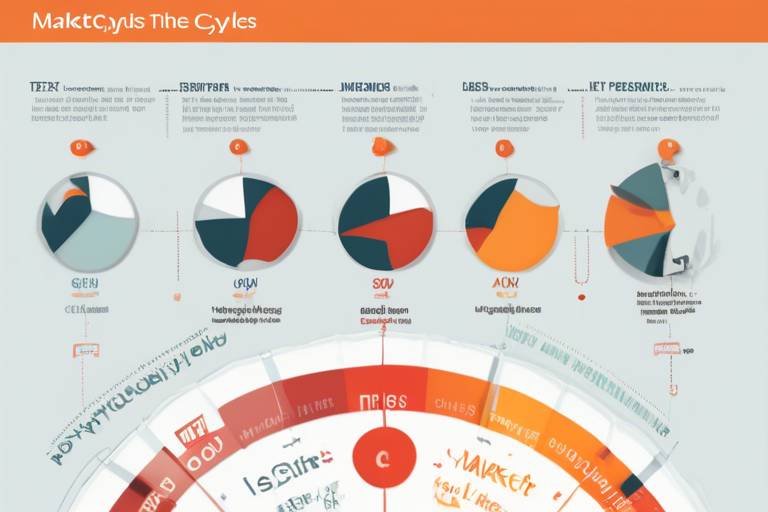The Role of Historical Trends in Market Analysis
This article explores how historical trends inform market analysis, providing insights into consumer behavior, economic shifts, and investment strategies that shape current market conditions.
Historical trends are patterns observed over time in market data, which help analysts predict future movements and understand the factors that influence market dynamics. Think of historical trends as a compass guiding businesses through the unpredictable waters of the market. By studying these patterns, analysts can discern not just where the market has been, but also where it might be headed. This understanding is crucial for making informed decisions that can enhance profitability and sustainability.
Data analysis plays a crucial role in identifying historical trends, allowing analysts to sift through vast amounts of information to extract meaningful insights for decision-making. In today’s data-driven world, the ability to analyze and interpret data effectively can mean the difference between success and failure. Analysts employ various techniques to evaluate data, ensuring they uncover the hidden stories that numbers can tell. This process often involves looking at historical data to identify patterns that can inform current strategies.
Various types of data, including sales figures, economic indicators, and consumer behavior metrics, are essential for recognizing trends and making informed market predictions. Each type of data serves a unique purpose in the analysis. For instance:
- Sales Figures: These provide a direct insight into consumer purchasing habits and business performance.
- Economic Indicators: Metrics such as GDP growth rates and unemployment figures help analysts gauge the overall economic environment.
- Consumer Behavior Metrics: Understanding how consumers interact with products can reveal valuable trends that inform marketing strategies.
When it comes to data analysis, both quantitative and qualitative data play pivotal roles. Quantitative data provides numerical insights that can be easily measured, such as sales volumes and market shares. On the other hand, qualitative data offers context and depth, capturing the emotions and motivations behind consumer choices. A comprehensive market analysis must incorporate both types of data to paint a complete picture of market dynamics.
Reliable historical data sources, such as government reports, academic research, and insights from market research firms, are essential for accurate trend analysis and forecasting. Utilizing trustworthy sources ensures that the data being analyzed is credible, which ultimately leads to more reliable insights. Analysts often create a data repository from these sources to facilitate easier access and analysis.
Utilizing advanced analytical tools and software enables market analysts to visualize trends, identify correlations, and enhance the accuracy of their forecasts. Tools like Tableau and Google Analytics allow analysts to create interactive dashboards that make it easier to spot trends at a glance. With the right tools, even the most complex data sets can be transformed into clear, actionable insights.
Economic events, such as recessions and booms, significantly impact historical trends, shaping market behavior and consumer sentiment over time. Understanding these events is crucial for analysts, as they provide context for the trends observed. For instance, during a recession, consumer spending typically decreases, which can lead to downward trends in various markets.
Understanding how past recessions affected market trends helps analysts anticipate potential downturns and strategize accordingly to mitigate risks. By examining historical data from previous recessions, analysts can identify common patterns that may re-emerge in future economic downturns. This foresight allows businesses to prepare for challenging times, ensuring they remain resilient.
Analyzing growth periods provides insights into successful market strategies and consumer preferences, which can guide future investments and business decisions. Growth periods are often characterized by increased consumer confidence and spending, making them ripe for investment opportunities. By studying the factors that contributed to past growth, analysts can better position their strategies for future success.
Examining specific case studies illustrates how historical trends have influenced market outcomes, offering valuable lessons for current market participants. For example, the technology sector has experienced rapid changes, and analyzing its historical trends reveals patterns that can inform future innovations and investments. Similarly, studying consumer goods trends over time highlights shifts in preferences and purchasing behavior, providing insights for marketers and manufacturers.
The technology sector has undergone significant transformations over the years. By analyzing historical trends, analysts can identify key innovations that have shaped the market landscape. Understanding these trends is essential for businesses aiming to stay ahead of the curve and capitalize on emerging technologies.
Studying consumer goods trends over time highlights shifts in preferences and purchasing behavior, providing insights for marketers and manufacturers. For instance, the rise of eco-friendly products has transformed the consumer goods market, compelling brands to adapt their strategies to meet changing consumer demands.
Understanding historical trends not only aids in current market analysis but also helps predict future market directions, enabling businesses to adapt and thrive in changing environments. By leveraging insights gained from past data, companies can make informed decisions that position them for long-term success. In a world where change is the only constant, historical trends serve as a valuable tool for navigating the complexities of the market.
- What are historical trends? Historical trends are patterns observed in market data over time that help predict future movements.
- Why is data analysis important in market analysis? Data analysis allows analysts to extract meaningful insights from vast amounts of information, guiding decision-making.
- What types of data are used in trend analysis? Analysts use sales figures, economic indicators, and consumer behavior metrics to recognize trends.
- How do economic events impact historical trends? Economic events like recessions and booms shape market behavior and consumer sentiment, influencing historical trends.

Understanding Historical Trends
Historical trends are not just numbers on a chart; they are the stories of markets, reflecting the collective behavior of consumers and the economic environment over time. By examining these trends, analysts can uncover patterns that reveal how markets have reacted to various stimuli, such as changes in consumer preferences, economic policies, or global events. This understanding is crucial for predicting future market movements and making informed decisions.
To grasp the essence of historical trends, one must consider the various factors that contribute to their formation. These factors include economic indicators like GDP growth, unemployment rates, and inflation, as well as consumer behavior metrics such as spending habits and brand loyalty. By analyzing these elements, we can piece together a comprehensive picture of market dynamics. For instance, during periods of economic growth, consumer spending typically increases, leading to higher sales figures. Conversely, during recessions, spending tends to decline, which can significantly impact various sectors.
Moreover, understanding historical trends involves recognizing the cyclical nature of markets. Just like the seasons change, markets go through cycles of growth, stagnation, and decline. By studying past cycles, analysts can identify potential turning points and make predictions about future movements. For example, if a particular industry has historically experienced growth following a recession, this knowledge can inform investment strategies during similar economic conditions.
In addition to recognizing cycles, analysts also benefit from understanding the context behind historical data. This means looking beyond the numbers to explore the reasons behind certain trends. For instance, if a spike in sales for a consumer product correlates with a major cultural event, it’s essential to consider how that event influenced consumer behavior. By connecting the dots between historical data and real-world events, analysts can gain deeper insights into market dynamics.
Ultimately, the study of historical trends is an ongoing process that requires continuous monitoring and analysis. As new data becomes available, trends can shift, and previously established patterns may no longer hold true. Therefore, staying informed and adaptable is key to leveraging historical insights for future market success.

The Importance of Data Analysis
Data analysis is the backbone of market analysis, acting as a guiding star for analysts navigating the vast ocean of information. In today’s fast-paced world, where data is generated at an unprecedented rate, the ability to sift through this information and extract meaningful insights is crucial. Think of data analysis as a magnifying glass that helps you spot the hidden patterns in a chaotic landscape. It allows analysts to not only observe what has happened in the past but also to make informed predictions about what might happen in the future.
One of the key reasons data analysis is so important is that it enables analysts to identify and understand historical trends. By examining past performance, analysts can uncover valuable insights into consumer behavior, economic shifts, and market dynamics. This understanding is essential for shaping current strategies and making sound investment decisions. Imagine trying to navigate a ship without a compass; without data analysis, companies would be sailing blind, unable to chart a course through the complexities of the market.
Moreover, data analysis allows for the segmentation of information into manageable pieces. Analysts can categorize data into various types, such as sales figures, economic indicators, and consumer behavior metrics. This segmentation makes it easier to recognize trends. For instance, when looking at sales data, analysts might notice a spike during holiday seasons, which could indicate a trend worth capitalizing on. By leveraging these insights, businesses can tailor their marketing strategies and product offerings to align with consumer demand.
In addition to identifying trends, data analysis also plays a pivotal role in risk management. By analyzing historical data, businesses can identify potential pitfalls and prepare for them in advance. For example, if an analysis reveals that certain products tend to underperform during economic downturns, companies can adjust their inventory or marketing strategies accordingly. This proactive approach to risk management can be the difference between thriving and merely surviving in a competitive marketplace.
Furthermore, the advent of advanced analytical tools and software has revolutionized the way data is analyzed. These tools not only enhance the accuracy of forecasts but also allow for the visualization of trends in a way that is easily digestible. For example, a simple graph can illustrate complex data points, making it easier for stakeholders to understand market conditions at a glance. This capability to visualize data is akin to turning a dense forest of numbers into a clear path, guiding businesses in their decision-making processes.
In conclusion, the importance of data analysis cannot be overstated. It serves as a vital tool for uncovering historical trends, managing risks, and making informed decisions in a rapidly changing market landscape. Without it, businesses would find themselves lost in a sea of data, unable to navigate the complexities of consumer behavior and economic shifts. As we move forward, embracing data analysis will be essential for any organization looking to succeed in today’s competitive environment.
- What types of data are most important for market analysis?
Sales figures, economic indicators, and consumer behavior metrics are crucial for identifying trends and making informed decisions.
- How can data analysis help in risk management?
By identifying potential pitfalls through historical data analysis, businesses can prepare and adjust their strategies to mitigate risks.
- What tools can enhance data analysis?
Advanced analytical tools and software can improve accuracy and help visualize trends, making data easier to understand.

Types of Data Used
When diving into the world of market analysis, understanding the types of data that are utilized is crucial. Analysts rely on a variety of data sources to construct a comprehensive view of market trends. This data can be broadly categorized into two main types: quantitative and qualitative. Each type plays a unique role in shaping our understanding of consumer behavior and market dynamics.
Quantitative data refers to any information that can be quantified or expressed numerically. This includes metrics like sales figures, market share percentages, and economic indicators such as GDP growth rates. For example, a company may analyze its sales data over the past five years to identify trends in consumer purchasing patterns. By examining these numbers, analysts can derive insights that help forecast future sales and market conditions.
On the other hand, qualitative data provides a deeper understanding of the reasons behind consumer behavior. This type of data is less about numbers and more about context. It includes insights gathered from customer feedback, interviews, and focus groups. For instance, a company might conduct surveys to understand why customers prefer one brand over another. The qualitative insights gained from these surveys can be invaluable, as they provide the emotional context behind the numbers.
To illustrate the importance of both types of data, consider a scenario where a retail company is analyzing its market position. The quantitative data might show a decline in sales, while the qualitative data could reveal that customers are dissatisfied with the product quality. This dual approach allows analysts to not only see the what but also the why behind market changes, enabling more effective decision-making.
Furthermore, the integration of both quantitative and qualitative data leads to more robust market predictions. Analysts often use tools and software that can handle large datasets, allowing for sophisticated analyses that uncover hidden trends. For example, a company might use statistical software to analyze sales data while simultaneously reviewing customer feedback to identify areas for improvement.
In summary, the types of data used in market analysis are essential for crafting a complete picture of market dynamics. By combining quantitative and qualitative insights, analysts can make informed predictions and strategic decisions that drive business success. The interplay between these data types not only enhances understanding but also equips businesses to navigate the ever-changing market landscape.

Quantitative vs. Qualitative Data
When diving into the world of market analysis, one of the essential distinctions to grasp is the difference between quantitative and qualitative data. These two types of data serve different purposes and provide unique insights that can significantly enhance our understanding of historical trends. Think of quantitative data as the backbone of your analysis—it's the hard numbers, the statistics, the data points that can be measured and compared. For example, sales figures, market share percentages, and economic indicators like GDP growth are all quantitative. They tell you how much, how many, and how often, allowing analysts to identify patterns and make predictions based on numerical evidence.
On the flip side, qualitative data adds a layer of depth and context that numbers alone can't provide. This type of data includes insights from customer interviews, surveys, and focus groups, revealing the why behind consumer behaviors and trends. For instance, while quantitative data might show a drop in sales, qualitative data can help uncover the reasons—perhaps consumers are shifting their preferences or facing economic hardships. Together, these two types of data create a comprehensive picture of the market landscape.
To illustrate their differences further, consider the following table:
| Aspect | Quantitative Data | Qualitative Data |
|---|---|---|
| Definition | Numerical data that can be measured | Descriptive data that provides context |
| Examples | Sales numbers, market share, profit margins | Customer feedback, interviews, focus group discussions |
| Usage | Identifying trends, measuring performance | Understanding motivations, exploring consumer sentiments |
| Analysis Methods | Statistical analysis, data modeling | Thematic analysis, content analysis |
In summary, both quantitative and qualitative data are indispensable in market analysis. While quantitative data provides the hard facts and figures that can be easily analyzed, qualitative data enriches our understanding by giving context to those numbers. By leveraging both types of data, analysts can paint a more complete picture of historical trends and make informed decisions that can shape future strategies.
- What is the main difference between quantitative and qualitative data? Quantitative data is numerical and measurable, while qualitative data is descriptive and provides context.
- Why is it important to use both types of data in market analysis? Using both types allows for a more comprehensive understanding of market dynamics, combining hard facts with insights into consumer behavior.
- Can qualitative data be quantified? While qualitative data is inherently descriptive, it can be coded and categorized to provide numerical insights, but this often requires careful interpretation.

Historical Data Sources
When it comes to analyzing historical trends, having access to reliable data sources is absolutely crucial. Think of historical data sources as the bedrock upon which all market analysis is built. Without solid data, predictions are little more than educated guesses. So, where do analysts turn to find this invaluable information? There are several key sources that stand out, each offering unique insights into past market behaviors.
One of the primary sources of historical data is government reports. These reports often provide comprehensive statistics on economic indicators such as GDP, unemployment rates, and inflation. They serve as a treasure trove of information for analysts looking to understand how macroeconomic factors have influenced market trends over time. For instance, during the last recession, government data revealed a spike in unemployment rates, which directly correlated with a significant drop in consumer spending.
Another vital source of historical data comes from market research firms. These organizations specialize in gathering and analyzing data related to consumer behavior, industry trends, and competitive landscapes. They often publish detailed reports that can illuminate shifts in consumer preferences over the years. For example, a market research report might reveal how the rise of e-commerce has gradually changed the landscape for traditional retail, providing insights into how businesses can adapt.
Additionally, financial institutions and stock exchanges maintain extensive databases that track historical stock prices, trading volumes, and other financial metrics. This data is essential for analysts who are trying to understand how market sentiment has shifted in response to various economic events. A well-rounded analysis often requires a combination of these different data sources to paint a complete picture.
To summarize, here are some of the most important historical data sources:
- Government Reports: Provide macroeconomic data and indicators.
- Market Research Firms: Offer insights into consumer behavior and industry trends.
- Financial Institutions: Track stock prices and trading data.
- Academic Publications: Provide research findings that can offer additional context.
In conclusion, leveraging these historical data sources allows analysts to not only understand past market trends but also to make informed predictions about future movements. As the saying goes, "Those who cannot remember the past are condemned to repeat it." In the world of market analysis, this couldn't be more accurate. With the right data at their fingertips, analysts can navigate the complexities of the market with confidence and foresight.
Q: Why is historical data important in market analysis?
A: Historical data helps analysts identify patterns and trends that can inform future market predictions, allowing businesses to make strategic decisions.
Q: What types of historical data are most useful?
A: Both quantitative data (like sales figures and stock prices) and qualitative data (like consumer sentiment) are essential for a comprehensive analysis.
Q: Where can I find reliable historical data?
A: Reliable sources include government reports, market research firms, and financial institutions that publish historical data and analyses.
Q: How do economic events affect historical trends?
A: Economic events like recessions or booms can significantly alter consumer behavior and market dynamics, making it crucial to study their impact on historical trends.

Tools for Analyzing Trends
In the ever-evolving landscape of market analysis, having the right tools at your disposal is akin to a chef having the best knives in the kitchen. These tools not only streamline the process but also enhance the accuracy of the insights gleaned from historical data. Analysts today are fortunate to have access to a myriad of advanced analytical tools and software that can transform raw data into meaningful trends. From data visualization platforms to sophisticated statistical software, each tool serves a unique purpose in the quest for market clarity.
One of the most popular tools in trend analysis is data visualization software. Programs like Tableau and Power BI allow analysts to create stunning visual representations of data, making it easier to spot patterns and anomalies. Imagine trying to find a needle in a haystack; without visualization, identifying trends in large datasets can feel just as daunting. With these tools, analysts can generate graphs, charts, and dashboards that not only simplify complex data but also make it accessible to stakeholders who may not have a deep understanding of the underlying numbers.
Another essential tool is statistical analysis software, such as R or Python with its various libraries. These tools enable analysts to perform complex calculations and run predictive models that can forecast future market movements based on historical data. For instance, using regression analysis, an analyst can determine the relationship between consumer spending and economic indicators, providing invaluable insights into how shifts in one could impact the other. This predictive capability is crucial for businesses looking to stay ahead of the curve.
In addition to software, there are also online platforms that aggregate and analyze market data. Websites like Statista and Google Trends provide real-time data and insights into consumer behavior, market demands, and emerging trends. By leveraging these platforms, analysts can keep their fingers on the pulse of the market, ensuring they are well-informed about the latest developments. The ability to access such information quickly can mean the difference between seizing an opportunity and watching it pass by.
Furthermore, collaboration tools like Microsoft Teams or Slack can enhance communication among team members working on trend analysis. When multiple analysts share insights and findings, they can collectively identify trends that might not be evident when working in isolation. This collaborative approach is akin to a band of detectives piecing together clues to solve a mystery; the more minds engaged, the clearer the picture becomes.
Ultimately, the choice of tools will depend on the specific needs of the analysis and the preferences of the analysts. However, integrating a combination of visualization, statistical analysis, and real-time data platforms will undoubtedly yield the most comprehensive insights. As the market continues to change, staying equipped with the right tools is essential for making informed decisions that can drive business success.
- What are the best tools for analyzing market trends?
Some of the best tools include data visualization software like Tableau, statistical analysis software like R and Python, and online platforms like Statista.
- How can data visualization help in trend analysis?
Data visualization helps simplify complex data, making it easier to spot patterns and communicate findings to stakeholders.
- Is statistical analysis necessary for trend analysis?
Yes, statistical analysis is crucial as it allows analysts to perform complex calculations and make accurate predictions based on historical data.
- Can online platforms provide real-time data for trend analysis?
Absolutely! Online platforms like Google Trends and Statista provide up-to-date insights into market demands and consumer behavior.

Impact of Economic Events
The world of finance is like a vast ocean, where economic events create waves that can either propel a ship forward or capsize it entirely. These events, such as recessions, booms, and even political shifts, have a profound influence on historical trends, shaping market behavior and consumer sentiment over time. Understanding these impacts is crucial for analysts and investors alike, as it allows them to navigate the turbulent waters of the market with greater confidence.
For instance, during a recession, consumer spending typically declines as people become cautious about their financial futures. This shift can be seen in various sectors, from luxury goods to everyday necessities. A historical analysis reveals that during past recessions, certain industries, like discount retailers, often thrive while others, such as high-end brands, struggle to stay afloat. Recognizing these patterns enables businesses to adjust their strategies accordingly, whether it means pivoting to more affordable product lines or enhancing marketing efforts to appeal to a more budget-conscious consumer base.
On the flip side, economic booms can lead to increased consumer confidence and spending, driving up demand across various sectors. Analyzing past economic growth periods can provide valuable insights into which industries tend to flourish during these times. For example, technology and entertainment sectors often see a surge in investment during boom periods as consumers are more willing to spend on innovations and leisure activities. The following table illustrates the correlation between economic events and sector performance:
| Economic Event | Impact on Consumer Behavior | Sector Performance |
|---|---|---|
| Recession | Increased savings, reduced spending | Discount retailers thrive, luxury brands decline |
| Economic Boom | Increased spending, high consumer confidence | Technology and entertainment sectors flourish |
Moreover, political events, such as elections or changes in government policy, can also lead to significant shifts in market trends. For instance, a change in administration may bring about new regulations that affect specific industries, leading to fluctuations in stock prices and consumer behavior. Understanding these dynamics is essential for making informed decisions and anticipating market movements.
In summary, the impact of economic events on historical trends cannot be overstated. By studying past recessions, growth periods, and political shifts, analysts can gain a deeper understanding of how these factors influence market behavior. This knowledge not only aids in current market analysis but also equips businesses with the tools to adapt and thrive in an ever-changing economic landscape.
- How do economic events influence consumer behavior? Economic events often lead to changes in consumer confidence, which can impact spending habits. For example, during a recession, consumers may prioritize saving over spending.
- What role do historical trends play in market predictions? Historical trends provide a framework for understanding past market behaviors, allowing analysts to make informed predictions about future movements.
- Can political events impact market trends? Yes, political events can significantly influence market trends, as changes in government policy or regulations can alter the landscape for various industries.

Recession Trends
Understanding is crucial for market analysts and businesses alike. Recessions, often characterized by a significant decline in economic activity, can drastically alter consumer behavior, investment strategies, and overall market dynamics. When we look back at historical data, we can see that recessions have a ripple effect that touches every corner of the economy. For instance, during the Great Recession of 2008, we witnessed a sharp decline in consumer spending, which in turn led to massive layoffs and a slowdown in production. This cycle of declining demand and increasing unemployment creates a challenging environment for businesses trying to navigate through tough times.
One of the most telling indicators of recession trends is the unemployment rate. As companies tighten their belts during economic downturns, layoffs become common. This not only affects the individuals who lose their jobs but also impacts those who remain employed, as they often become more cautious with their spending. A rise in unemployment typically correlates with a decrease in consumer confidence, leading to further reductions in spending. Analyzing past recessions reveals patterns in how quickly consumer confidence can be restored once the economy begins to recover.
Moreover, historical trends show that certain sectors are more vulnerable during recessions. For example, luxury goods and non-essential services often see a significant drop in demand, while essential goods tend to remain stable. This pattern can be illustrated in the table below:
| Sector | Impact During Recession |
|---|---|
| Luxury Goods | Significant decline in sales |
| Consumer Essentials | Stable or slight increase in demand |
| Entertainment | Decrease in discretionary spending |
| Healthcare | Stable demand due to necessity |
Another important aspect of recession trends is the government response. Historical analysis shows that governments often implement stimulus measures to counteract the effects of a recession. These measures can include tax cuts, increased public spending, and monetary policy adjustments like lowering interest rates. By examining how previous recessions were handled, analysts can better predict the potential effectiveness of similar strategies in future downturns.
In conclusion, recognizing and understanding recession trends is not just about looking at numbers; it's about interpreting the stories those numbers tell. By analyzing historical data on consumer behavior, sector performance, and government interventions, businesses can better prepare for the inevitable economic cycles. This preparedness can make all the difference in not only surviving a recession but also emerging stronger on the other side.
- What are the main indicators of a recession? Common indicators include rising unemployment rates, declining GDP, and reduced consumer spending.
- How can businesses prepare for a recession? Businesses can prepare by diversifying their offerings, maintaining a healthy cash reserve, and closely monitoring market trends.
- What sectors typically perform well during a recession? Essential goods, healthcare, and discount retailers often perform better during economic downturns.

Growth Periods
Growth periods in the market are like the sun breaking through the clouds after a storm—offering warmth, light, and opportunities for growth. These are the times when economies flourish, consumer spending rises, and businesses expand. Understanding these periods is vital for analysts and investors alike, as they provide critical insights into successful market strategies and consumer preferences. But how do we define a growth period? Generally, it’s characterized by a sustained increase in economic activity, often measured by GDP growth, rising employment rates, and increased consumer confidence.
During growth periods, businesses often experience an uptick in sales, which leads to higher profits and the potential for reinvestment. This cycle can create a positive feedback loop, where increased revenues allow for expansion, which in turn fuels further economic growth. For example, the post-recession recovery seen in the early 2010s was marked by significant growth in technology and consumer goods sectors. Companies that adapted quickly to changing consumer demands and technological advancements not only survived but thrived, setting new standards for success.
One key aspect of analyzing growth periods is understanding consumer behavior. During these times, consumers tend to be more willing to spend, influenced by factors such as rising disposable incomes and favorable economic conditions. This shift in behavior can lead to changes in market dynamics, prompting businesses to innovate and diversify their offerings to capture consumer interest. For instance, during the growth period of the late 1990s, the tech boom led to an explosion of new products and services, reshaping the landscape of the market.
To illustrate the impact of growth periods, let’s take a look at a table summarizing key economic indicators during a notable growth period:
| Year | GDP Growth (%) | Unemployment Rate (%) | Consumer Confidence Index |
|---|---|---|---|
| 1997 | 4.5 | 4.9 | 100.2 |
| 1998 | 4.4 | 4.5 | 104.0 |
| 1999 | 4.8 | 4.2 | 108.0 |
This table highlights a period of strong economic performance, showcasing how GDP growth correlates with low unemployment and high consumer confidence. These indicators are essential for businesses looking to make informed decisions about investment and expansion. By analyzing such data, analysts can identify patterns that not only explain past successes but also help predict future trends.
In conclusion, growth periods represent a unique opportunity for businesses to capitalize on favorable conditions. By staying attuned to the factors that drive these periods, companies can position themselves strategically to harness the potential of a thriving market. As we navigate through various economic climates, understanding the dynamics of growth periods will be crucial for making informed decisions that can lead to long-term success.
- What defines a growth period in the market? A growth period is typically marked by sustained increases in economic activity, including rising GDP, employment rates, and consumer confidence.
- How can businesses benefit from growth periods? Businesses can leverage growth periods to increase sales, expand operations, and innovate their product offerings, taking advantage of heightened consumer spending.
- What role does consumer behavior play during growth periods? Consumer behavior tends to shift towards increased spending during growth periods, influenced by factors like rising incomes and positive economic outlooks.

Case Studies of Historical Trends
Examining specific case studies illustrates how historical trends have influenced market outcomes, offering valuable lessons for current market participants. One of the most prominent examples can be found in the technology sector, where rapid advancements and shifts in consumer demand have created a dynamic landscape. By analyzing historical trends in this sector, we can uncover patterns that not only inform current strategies but also guide future innovations. For instance, the rise of smartphones revolutionized communication and computing, reflecting a significant shift in consumer behavior. As analysts look back, they can see how early adopters of mobile technology paved the way for today’s market leaders.
Another compelling case study is in the consumer goods industry. Over the last few decades, there has been a noticeable shift in consumer preferences toward sustainability and ethical sourcing. This trend can be traced back to various economic and social movements, which have influenced purchasing behaviors significantly. For example, a study conducted by a leading market research firm revealed that brands that embraced sustainability saw a marked increase in sales compared to those that did not. This case study highlights the importance of adapting to consumer sentiment and market demands, showcasing how historical trends can guide businesses in making informed decisions.
To further emphasize the impact of these trends, let’s take a look at a comparative analysis of two major brands within the consumer goods sector. Below is a table illustrating the sales growth of Brand A, which focused on sustainable practices, versus Brand B, which did not prioritize sustainability:
| Year | Brand A (Sustainable Practices) | Brand B (Traditional Practices) |
|---|---|---|
| 2018 | $500,000 | $450,000 |
| 2019 | $750,000 | $470,000 |
| 2020 | $1,000,000 | $480,000 |
| 2021 | $1,250,000 | $490,000 |
This table clearly shows how Brand A's commitment to sustainability has directly correlated with its sales growth, while Brand B has struggled to keep pace. Such case studies are not just numbers; they are narratives that reflect broader societal values and consumer expectations. By understanding these historical trends, businesses can better position themselves to meet the evolving demands of their customers.
In conclusion, the exploration of historical trends through case studies provides invaluable insights into market behavior. Whether it’s the tech industry or consumer goods, these lessons from the past can illuminate the path forward for companies looking to thrive in an ever-changing landscape. As we continue to analyze these trends, it becomes increasingly clear that the ability to adapt and respond to historical patterns is crucial for long-term success.
- What are historical trends in market analysis?
Historical trends are patterns observed over time in market data that help analysts predict future movements and understand market dynamics. - Why are case studies important?
Case studies provide real-world examples of how historical trends have influenced market outcomes, offering valuable lessons for current market participants. - How can I analyze historical trends?
Utilizing various data sources and analytical tools can help you identify and understand historical trends in your specific market.

Technology Sector Trends
The technology sector is a dynamic and ever-evolving landscape that significantly influences global markets. Over the past few decades, we've witnessed remarkable transformations driven by rapid advancements in innovation, consumer demands, and economic shifts. Understanding these historical trends in technology not only helps businesses strategize effectively but also guides investors in identifying lucrative opportunities. For instance, the rise of the internet in the late 1990s catalyzed a digital revolution, leading to the creation of tech giants like Google and Amazon. These companies didn't just adapt to changes; they shaped the market by anticipating consumer needs and leveraging emerging technologies.
One of the most striking trends in the technology sector has been the transition from hardware-centric products to software-driven solutions. This shift has redefined how companies operate and interact with consumers. Consider the success of software-as-a-service (SaaS) models, which have gained immense popularity in recent years. Businesses can now access powerful software tools without the burden of hefty upfront costs, resulting in a more agile and scalable approach to operations. This trend is reflected in the growth of companies like Salesforce and Zoom, which have thrived by offering flexible, cloud-based solutions that cater to diverse business needs.
Moreover, the advent of artificial intelligence (AI) and machine learning has revolutionized the technology landscape. These technologies are not just buzzwords; they are pivotal in driving efficiency and innovation across various sectors. Companies that harness AI for data analysis, customer service, and product development are witnessing substantial competitive advantages. A recent report indicated that organizations implementing AI technologies saw a 30% increase in productivity within the first year. This trend underscores the importance of staying ahead of technological advancements to remain relevant in a rapidly changing market.
To visualize these trends, consider the following table that highlights the growth of key technology segments over the past decade:
| Technology Segment | 2013 Market Value (in billions) | 2023 Market Value (in billions) | Growth Rate (%) |
|---|---|---|---|
| Cloud Computing | 60 | 400 | 566% |
| Artificial Intelligence | 1.5 | 190 | 12667% |
| Internet of Things (IoT) | 10 | 250 | 2400% |
This table illustrates the phenomenal growth of these segments, emphasizing the need for businesses to adapt and innovate continuously. In addition to these trends, the technology sector is also witnessing a surge in sustainability initiatives. Companies are increasingly aware of their environmental impact and are investing in green technologies. This shift not only caters to the growing consumer demand for sustainable products but also positions companies as responsible market players. For example, tech firms are exploring renewable energy sources to power data centers and developing energy-efficient devices.
In conclusion, the historical trends in the technology sector provide a roadmap for navigating the complexities of modern markets. By understanding past behaviors and innovations, businesses can make informed decisions that align with future developments. As we look ahead, it's clear that the technology sector will continue to evolve, presenting both challenges and opportunities for those willing to embrace change.
- What are the key trends currently shaping the technology sector?
Key trends include the rise of cloud computing, the integration of AI and machine learning, and a focus on sustainability.
- How can businesses leverage historical trends in technology?
Businesses can analyze past trends to identify patterns, anticipate consumer needs, and adapt their strategies accordingly.
- Why is data analysis important in understanding technology trends?
Data analysis helps businesses extract meaningful insights from vast amounts of information, enabling informed decision-making.

Consumer Goods Trends
The world of consumer goods is a fascinating landscape, constantly evolving in response to changing preferences, technological advancements, and economic conditions. Understanding is crucial for businesses looking to stay ahead of the curve. These trends not only reflect the purchasing habits of consumers but also provide insights into broader market dynamics. For instance, the rise of e-commerce has transformed how consumers shop, leading to a significant shift in demand for online retail platforms and home delivery services.
One of the most notable trends in recent years is the increasing focus on sustainability. Consumers are becoming more environmentally conscious, seeking products that are eco-friendly and ethically sourced. This shift is prompting companies to innovate their product lines, incorporating sustainable practices in production and packaging. According to a recent survey, 75% of consumers are willing to pay more for sustainable products, highlighting the importance of this trend in shaping market strategies.
Another significant trend is the personalization of consumer goods. With advancements in data analytics and artificial intelligence, companies can now tailor their offerings to meet the specific needs and preferences of individual consumers. This level of customization not only enhances customer satisfaction but also fosters brand loyalty. For example, beauty brands are leveraging technology to create personalized skincare products based on individual skin types and concerns.
To illustrate the impact of these trends, consider the following table that presents key consumer goods trends over the past few years:
| Year | Trend | Impact |
|---|---|---|
| 2020 | Sustainability | Increased demand for eco-friendly products |
| 2021 | Personalization | Higher customer satisfaction and loyalty |
| 2022 | Health and Wellness | Growth in demand for organic and health-focused products |
| 2023 | Digital Shopping | Shift towards online retail and home delivery |
Moreover, the impact of social media cannot be overlooked. Platforms like Instagram and TikTok have become powerful marketing tools, influencing consumer behavior and trends. Brands that effectively leverage social media can create buzz around their products, reaching a broader audience and driving sales. The power of influencer marketing has also surged, with consumers often looking to their favorite personalities for recommendations.
In conclusion, understanding is essential for businesses aiming to thrive in a competitive market. By staying attuned to shifts in consumer preferences and leveraging technology, companies can adapt their strategies to meet the evolving demands of their customers. As we look toward the future, it’s clear that those who embrace change and innovate will be the ones to lead the market.
- What are consumer goods trends? Consumer goods trends refer to the patterns and shifts in consumer behavior and preferences regarding products, influencing how businesses market and sell their goods.
- Why are sustainability trends important? Sustainability trends are important because they reflect consumers' growing concern for the environment, prompting companies to adopt eco-friendly practices that can enhance brand loyalty and market appeal.
- How does social media influence consumer goods trends? Social media influences consumer goods trends by shaping public perception and preferences, with brands using these platforms to engage with customers and promote their products.

Future Implications of Historical Trends
Understanding historical trends is like holding a map to the future; it provides invaluable insights that can guide businesses through the ever-changing landscape of the market. By analyzing past behaviors and patterns, companies can forecast potential shifts in consumer preferences, economic conditions, and technological advancements. This foresight allows businesses to not only react to changes but also to proactively shape their strategies to stay ahead of the curve.
For instance, consider how the rise of e-commerce was predicted by analyzing historical data on consumer spending and technological adoption. As more people began to shop online, businesses that recognized this trend early on were able to pivot their strategies, invest in digital platforms, and ultimately thrive in a competitive environment. In contrast, those who ignored these signs faced significant challenges, highlighting the critical nature of trend analysis in strategic planning.
Moreover, historical trends can reveal cyclical patterns that indicate when to invest or divest. For example, historical data might show that certain industries tend to flourish during specific economic conditions. By identifying these cycles, investors can make informed decisions about where to allocate resources. This predictive capability is essential for minimizing risks and maximizing returns in an unpredictable market.
Another fascinating aspect of historical trends is their ability to inform marketing strategies. By understanding how consumer behavior has evolved, companies can tailor their messaging and product offerings to align with current expectations. For example, if historical data shows a growing preference for sustainability, brands can emphasize their eco-friendly practices in marketing campaigns, appealing to a conscientious consumer base. This alignment not only boosts sales but also enhances brand loyalty.
As we look to the future, the implications of historical trends become even more pronounced. Companies that leverage these insights are better positioned to adapt to changes, innovate their offerings, and meet consumer demands effectively. In a world where change is the only constant, the ability to anticipate and respond to market dynamics is paramount for success.
- What are historical trends?
Historical trends are patterns observed over time in market data that help analysts predict future movements and understand the factors influencing market dynamics. - Why are historical trends important for businesses?
They help businesses anticipate changes in consumer behavior, economic conditions, and market dynamics, enabling them to make informed decisions and adapt strategies. - How can businesses analyze historical trends?
Businesses can analyze historical trends by collecting data from various sources, using analytical tools, and interpreting the data to identify patterns and correlations. - What types of data are used in historical trend analysis?
Common data types include sales figures, economic indicators, and consumer behavior metrics, which provide a comprehensive view of market conditions.
Frequently Asked Questions
- What are historical trends in market analysis?
Historical trends refer to patterns observed in market data over time. These trends help analysts understand consumer behavior, economic shifts, and investment strategies that shape current market conditions.
- Why is data analysis important for identifying historical trends?
Data analysis is crucial because it allows analysts to sift through large amounts of information to extract meaningful insights. This helps in making informed decisions based on past market behaviors and trends.
- What types of data are used to analyze historical trends?
Various types of data are utilized, including sales figures, economic indicators, and consumer behavior metrics. Each type provides valuable insights necessary for recognizing trends and making accurate market predictions.
- What is the difference between quantitative and qualitative data?
Quantitative data provides numerical insights, while qualitative data offers context and depth. Both are essential for a comprehensive market analysis, as they help paint a fuller picture of market dynamics.
- Where can I find reliable historical data sources?
Reliable sources include government reports, market research firms, and industry publications. These sources are essential for conducting accurate trend analysis and forecasting future market movements.
- What tools are commonly used for analyzing historical trends?
Advanced analytical tools and software are commonly used, enabling market analysts to visualize trends, identify correlations, and enhance the accuracy of their forecasts. Popular tools include Excel, Tableau, and specialized market analysis software.
- How do economic events impact historical trends?
Economic events like recessions and booms significantly influence historical trends. They shape market behavior and consumer sentiment, which analysts must consider when predicting future market conditions.
- What can we learn from past recessions regarding market trends?
Studying past recessions helps analysts understand how market trends were affected, enabling them to anticipate potential downturns and strategize accordingly to mitigate risks in the future.
- How do growth periods influence market analysis?
Analyzing growth periods provides insights into successful market strategies and consumer preferences. This information can guide future investments and business decisions, helping companies to thrive in a competitive environment.
- What are some examples of historical trends in the technology sector?
The technology sector has experienced rapid changes, and analyzing its historical trends reveals patterns that can inform future innovations and investments. For instance, trends in software development and hardware advancements can guide new product launches.
- How do consumer goods trends evolve over time?
Studying consumer goods trends highlights shifts in preferences and purchasing behavior. This information is crucial for marketers and manufacturers to adapt their strategies and meet changing consumer demands.
- Why is understanding historical trends important for the future?
Understanding historical trends not only aids in current market analysis but also helps predict future market directions. This enables businesses to adapt and thrive in changing environments, ensuring long-term success.



















